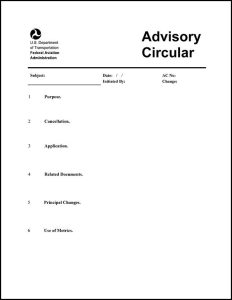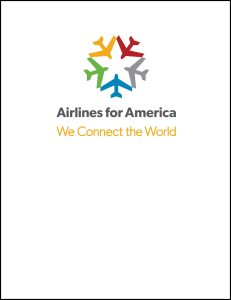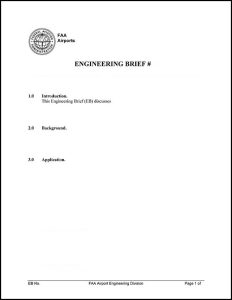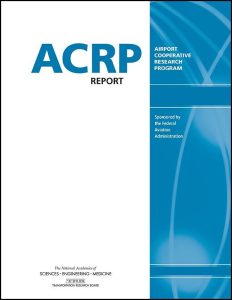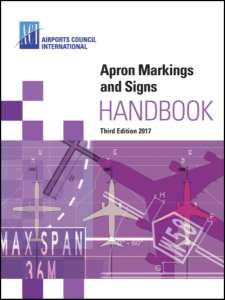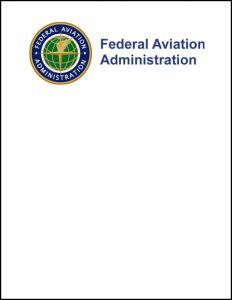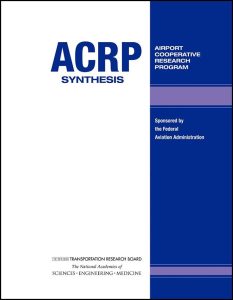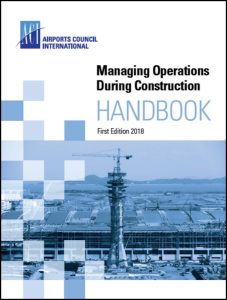To narrow the library of airside resources, use the filter boxes or airport map below or search box above.
Click an item below to expand.
Resources Matching Your Search
2020
This advisory circular (AC) contains FAA standards for markings used on airport runways, taxiways, and aprons. The runway markings addressed include landing designator, centerline, threshold, aiming point, touchdown zone, edge, threshold bar, displaced threshold, hold position, chevrons for blast pads, stopways, engineered material arresting system (EMAS), and shoulder markings.
2017
Although numerous standards and recommended practices for pedestrian and aircraft ground movement have been developed over time, only limited guidance is available regarding ground support equipment movement, parking on the ramp, and aircraft engine intake hazard zones. The document is offered for free through the A4A website and is emailed for download after a no-cost purchase process.
2021
This advisory circular (AC) provides guidance on the design and evaluation of pavements used by aircraft at civil airports. It addresses soil investigations and evaluation; flexible and rigid pavement design; pavement maintenance, rehabilitation and reconstruction; pavement structural analysis and pavement design for shoulders.
2017
This advisory circular (AC) sets forth guidelines for operational safety in airports during construction. This AC assists airport operators in complying with Title 14 Code of Federal Regulations (CFR) Part 139, Certification of Airports. For those certificated airports, this AC provides one way, but not the only way, of meeting those requirements. The use of this AC is mandatory for those airport construction projects receiving funds under the Airport Improvement Program (AIP). Chapters include planning an airfield construction project, construction safety phasing plans (CSPP), and guidelines for writing a CSPP. Included in the appendices are a safety and phasing checklist and a construction project daily safety inspection checklist.
2007
Engineering Brief (EB) 75 provides interim guidance for the planning and design of taxiway and apron improvements to minimize the likelihood of runway incursions. This guidance provides recommended taxiway and apron layouts to enhance runway safety by encouraging certain configurations and identifying layouts to avoid, when possible.
2012
ACRP Report 62 presents a compilation of apron safety statistics from U.S. and non-U.S. airports to draw conclusions as to the apparent effectiveness of apron management programs around the world. Through a common set of data and consistent definitions, the report is able to compare and contrast apron management programs around the world to U.S. airports, while considering the common operational and ownership differences between U.S. and non-U.S. airports.
2013
ACRP Report 96 provides best practices for planning, designing, and marking apron areas for all sizes and types of airports in the United States. Apron planning and design considerations include facility geometrics, aircraft maneuvering, apron/airfield access points, operational characteristics, markings, lighting, and aircraft fleets. The report summarizes apron planning and design best practices for incorporating flexibility, increasing efficiency, and enhancing the safety of apron facilities.
2015
This document outlines industry practices that minimize the hazards associated with severe weather in the aviation workplace. The document is offered for free through the A4A website and is emailed for download after a no-cost purchase process.
2017
This updated version of the Apron Markings and Signs Handbook includes best practices for the application and maintenance of paint markings on aprons. The aim of the handbook is to promote the commonality of markings worldwide and the increasing acceptance and application of these practices, leading to a safer apron environment. These markings and signs supplement those provided in ICAO Annex 14, Volume I, and the ICAO Aerodrome Design Manual, Part 4 (Visual Aids). This resource is available from the ACI store for $180 for members and $1,000 for non-members.
2015
The purpose of the ACI Apron Safety Handbook was to update and expand Chapter 2 of the Airside Safety Handbook (fourth edition). Aprons are the most congested and busiest areas of an airport, with complex activities that are carried out under severe space and time constraints. This handbook provides best practices for planning and designing apron layouts and facilities. It also provides standard operational practices for safe apron operations as well as mitigation and prevention measures for maintenance and construction activities on aprons. This resource is available from the ACI store for $125 for members and $1,000 for non-members.
2020
This desk reference provides explanatory guidance for environmental impact analysis performed to comply with Council on Environmental Quality (CEQ) Regulations for Implementing the Procedural Provisions of the National Environmental Policy Act (CEQ Regulations) (40 Code of Federal Regulations (CFR) parts 1500-1508); U.S. Department of Transportation (DOT) Order 5610.1C, Procedures for Considering Environmental Impacts; and Federal Aviation Administration (FAA) Order 1050.1F Environmental Impacts: Policies and Procedures.
2014
This advisory circular (AC) provides guidelines and procedures for maintaining airport pavements. It provides information on the types of pavement distress that occur to airport pavements and typical corrective action during preventive and remedial maintenance activities. Typical preventive and regular or recurring pavement maintenance includes: routine cleaning, filling, and/or sealing of cracks; patching pavement; seal coating; grading pavement edges; maintaining pavement drainage systems; and restoring pavement markings. Timely maintenance and repair of pavements is essential in maintaining adequate load-carrying capacity, good ride quality necessary for the safe operation of aircraft, good friction characteristics under all weather conditions, and minimizing the potential for foreign object debris (FOD).
2014
This advisory circular (AC) discusses the airport pavement management program (PMP) concept, its basic essential components, and how it is used to make cost-effective decisions about pavement maintenance and rehabilitation (M&R). The terms pavement management program (PMP), pavement maintenance-management program (PMMP), and pavement management system (PMS) are interchangeable.
2020
Part 2 assists countries in the implementation of the specifications for the design of taxiways and helps ensure their uniform application. This resource includes material on the general layout and description of updated design criteria for taxiway physical characteristics, including the shoulder and strips. This resource is available at the ICAO store for $200.
2011
ACRP Synthesis 29 addresses the current state of ground-handling practices, focusing on safety measures and training. Issues addressed in the report include ramp safety operations, staff roles and responsibilities, safety training, audit and inspection programs, safety violation programs, and collaborative safety initiatives, such as foreign object debris programs.
2018
These are guidelines for airport authorities, aircraft operators, and ground handling agents to help develop rules or regulations for driving on the ramp or apron. The airport authority should take the lead in developing the program that deals with driving on the ramp/apron to ensure consistency. The aircraft operators or ground handling vendors will train employees on the specific equipment and operating around aircraft. The document is offered for free through the A4A website and emailed for download after a no-cost purchase process.
2018
Construction activities can have a variety of impacts on the daily operations of an airport. To address this issue, a working group of the ACI World Safety and Technical Standing Committee developed the Managing Operations During Construction Handbook, which consists of best practices and case studies. The focus of this manual is on construction projects that affect the safety and efficiency of airside operations. The handbook presents a summary of the issues that airport operators should consider in developing management plans for operations during construction works. This handbook is for reference by airport operators, project managers, security agencies, aircraft operators, air navigation service providers, civil aviation authorities, contractors, and local communities. This resource is available from the ACI store for $180 for members and $1,000 for non-members. There is also a short course on the topic available from ACI for $95.
2009
This guidebook provides information to help municipal airport managers better understand and work with agricultural spraying operations. The guidebook's topics include laws, record-keeping requirements, operational issues, material storage, insurance, and emergency response plans related to agricultural spraying. This document includes a sample operator agreement.
2015
This advisory circular (AC) provides guidance for the preparation of master plans for airports that range in size and function, from small general aviation to large commercial service facilities. The intent of this AC is to foster a flexible approach to master planning that directs attention and resources to critical issues. The scope of each master plan must be tailored to the individual airport under evaluation.
2015
This advisory circular (AC) provides guidance for airport sponsors in the selection and engagement of architectural, engineering, and planning consultants. It also discusses services that normally would be included in an airport grant project, types of contracts for these services, contract format and provisions, and guidelines for determining the reasonableness of consultant fees.
